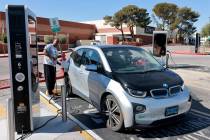Plug into electric car revolution
So, you’re interested in electric vehicles, but you have a few concerns. For one, they cost too much; two, you’re not sure whether they fit your lifestyle; and three, where will you charge it? Perhaps surprisingly, there are plenty of upcoming vehicle choices, several recharging options and even tax credits to help buyers with the cost. Read on.
Plug-ins tend to cost a little more because the technology is newer than that in standard gas guzzlers. As technology improves and becomes more common, prices will come down, but, in the meantime, the government is here to help.
Under the American Recovery and Reinvestment Act of 2009, federal income tax credits are available to U.S. citizens who purchase plug-in electric drive vehicles or modify existing vehicles to become “plug-ins” during 2009 and 2010.
The vehicle must have at least 5 kilowatt-hours of battery pack energy capacity driving the wheels of the vehicle to qualify for the base tax credit of $2,500 plus $417 for a total of $2,917. For each additional kilowatt-hour of battery pack energy capacity, the vehicle owner qualifies for another $417 of tax credit up to a maximum of $7,500 or about 16 kilowatt-hours of battery energy capacity onboard.
Now, let’s look at what types of vehicles and drive trains there are to choose from.
General Motors Corp. is currently leading the plug-in electric revolution with its upcoming Chevrolet Volt, which features an innovative Voltec hybrid platform. The Volt introduced a new category of automobile that has been described both as an extended-range electric vehicle and as a plug-in hybrid electric vehicle. The electric traction motor of the Volt drives the wheels of the car at all times, primarily from the power provided by a lithium-ion battery pack. The Voltec system can also be configured with a variety of fuels (gasoline, biodiesel or hydrogen fuel cell) that provide power to range-extending generators. These generators then use the fuel to create supplemental electric current to recharge the battery pack of the vehicle during operation, when it approaches a minimum power capacity threshold.
To differentiate the Volt from other hybrids, the Volt can be plugged into an AC power source when not in use to recharge the battery pack without using supplemental fuel. In normal urban driving environments, the Volt should be able to travel 40 miles in electric-only mode before needing supplemental support from the auxiliary engine/generator. The Volt’s estimated base price is $40,000, but it will likely be eligible for the maximum tax credit of $7,500.
In contrast, the Toyota Synergy drive train uses a parallel hybrid gasoline/electric system where the wheels of the vehicle can be driven by the electric motor, the gasoline engine or both. However, the Toyota Prius uses a relatively small nickel-metal hydride battery pack and can only travel about one or two miles in electric-only mode before the gasoline engine kicks in to recharge the pack. Having successfully integrated the Synergy parallel hybrid system across its product lines, from midsize and full-size sedans to SUVs, Toyota plans to introduce a plug-in version of the Prius with an extended-range battery pack during 2010.
Currently, Ford Motor Co. and Chrysler are making efforts to produce battery-electric vehicles within the next two years. BEVs, such as the sporty Tesla Motors Roadster, use only electricity from onboard storage batteries to power the vehicle’s drive train.
Ford hopes to have an all-electric Focus compact to market as early as 2011, while Chrysler has plans to produce the Dodge Circuit sports car to compete with the Tesla Roadster. The plug-in, electric-powered Circuit will have a range of 150 to 200 miles and will be able to accelerate from zero to 60 mph in less than five seconds with a 200 kilowatt electric motor (equivalent to about 268 horsepower).
The international automotive industries of Europe, Japan, China, India, and South Korea have already been developing products for the plug-in electric vehicle market and will continue to put pressure on the U.S. automotive industry to compete globally. BMW has already introduced the Mini-E, an all-electric version of the popular Mini Cooper, into Southern California at a lease price of $865 per month for selected evaluation customers.
As a result, there should be lots of “plug-in” choices available to U.S. consumers during 2010 and 2011. So, after buying a new PEDV and receiving a tax credit, where do you go to plug into the electric car revolution?
Fortunately, improved technology has shrunk the size and weight of recharging equipment over the years, so most of it can be integrated into vehicles via battery management systems. And luckily, there are three ways to plug in.
Level 1 is based on a standard household 120-volt outlet, which is commonly used to power small appliances and can be found throughout the U.S. Unfortunately, because of its relatively slow rate of charge, Level 1 stations are used only when a level 2 or level 3 source of power cannot be found.
Level 2 is based on a 240-volt, single phase, 40-amp branch circuit that implements a faster power transmission rate. Most residential homes in the U.S. are wired with this type of power configuration to accommodate electric clothes dryers and stoves.
Level 3 is set aside for commercial and public “fast charging,” where users can recharge quickly, serving a purpose similar to a gas station. Level 3 station AC-to-DC conversion electronics are “off-board” the electric vehicle and recharge a battery pack to 50 percent capacity within 15 to 30 minutes.
Locally, Rampart Casino’s valet offers a level 3 charging station, provided by EV-Charge America. Guests who use the station can be comped or billed by the casino.
For more information, contact the Rampart Casino at the Resort at Summerlin at 507-5900 or contact EV-Charge America at 696-1600.
Stan Hanel has worked in the electronics industry for more than 30 years and is a long-time member of the Electric Auto Association and the Las Vegas Electric Vehicle Association. Hanel writes and edits for EAA’s “Current Events” and LVEVA’s “Watts Happening” newletters. Contact him at stanhanel@aol.com.


















